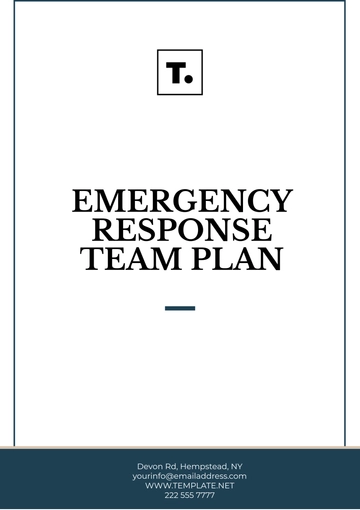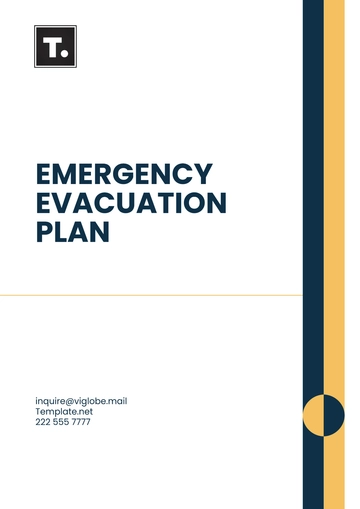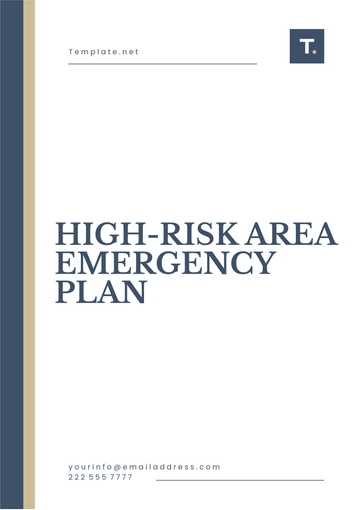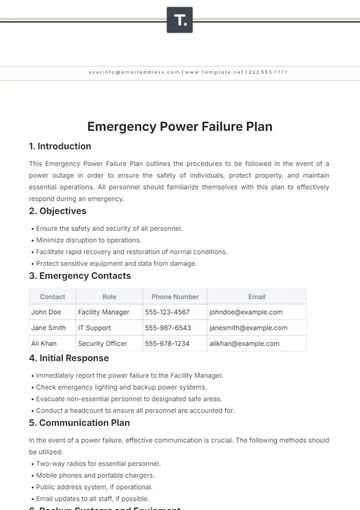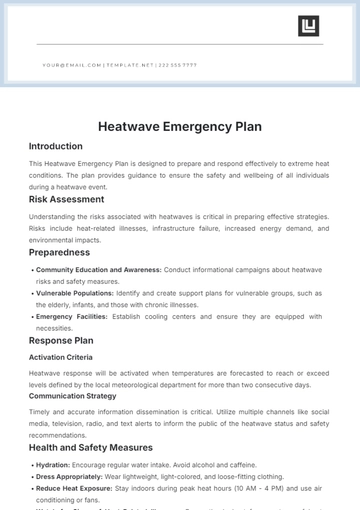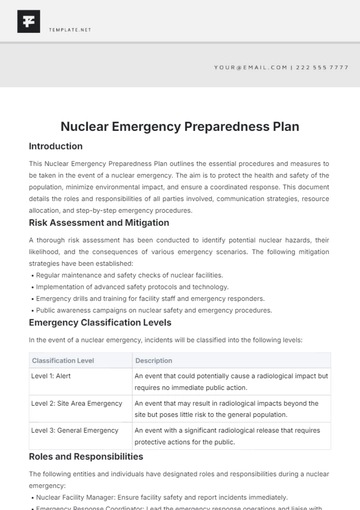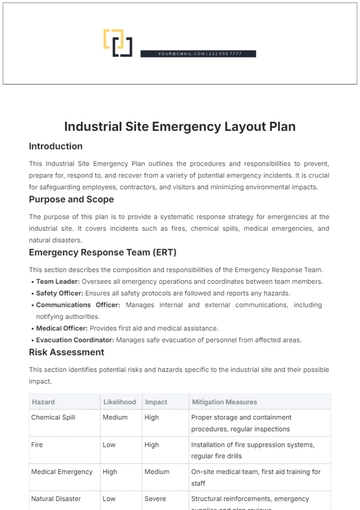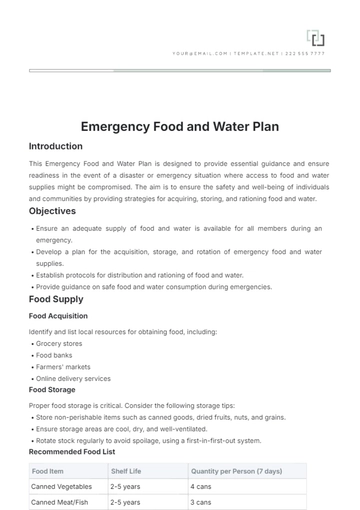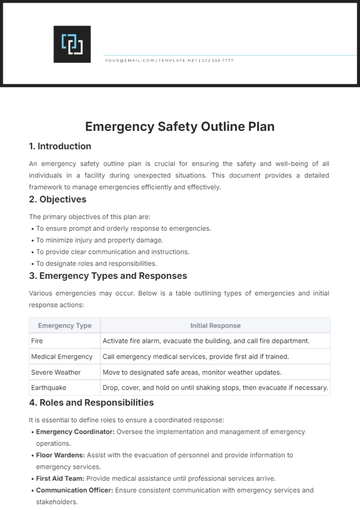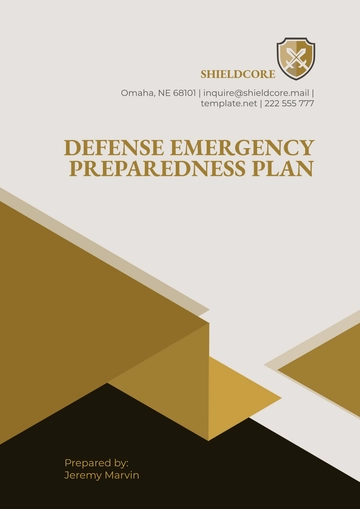Free Telecommunication Emergency Response Plan
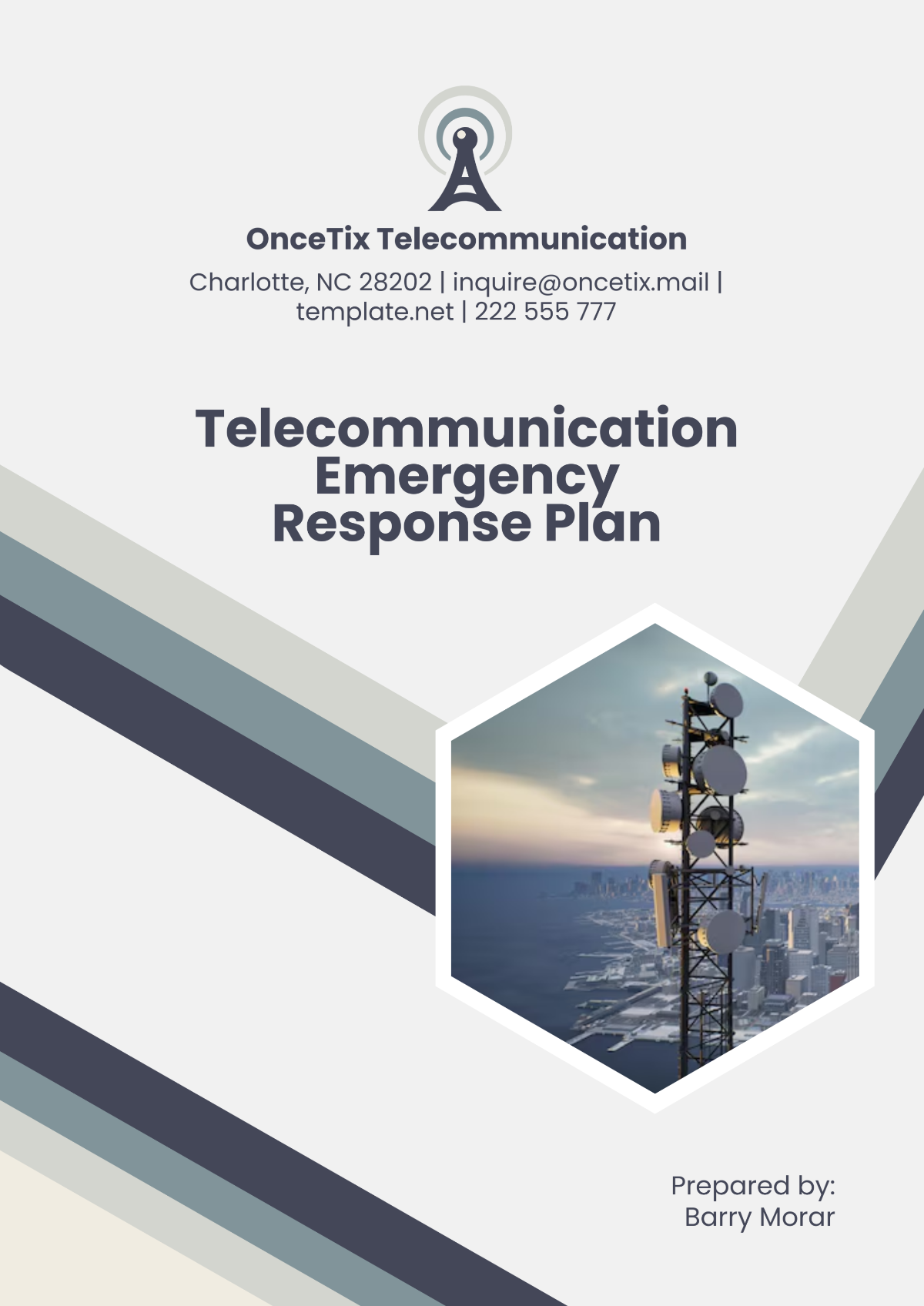
I. Introduction
A. Purpose of the Plan
The purpose of [Your Company Name]'s Telecommunication Emergency Response Plan (TERP) is to ensure that the telecommunications network remains operational during and after an emergency. This plan outlines procedures to prevent disruptions and restore services quickly in the event of incidents such as natural disasters, system failures, or cyberattacks. The goal is to minimize downtime and ensure continuous communication for critical services.
B. Scope
This plan covers all critical telecommunication systems, including voice, data, and internet services, across all facilities and service areas. It applies to all employees, contractors, and third-party vendors who are involved in managing or supporting the network infrastructure. The scope also includes disaster recovery for both hardware and software components of the telecommunication systems.
C. Objectives
The key objectives of this plan are:
To ensure rapid detection and assessment of emergency incidents.
To provide clear action steps for immediate response and recovery.
To maintain business continuity and minimize the impact on customers.
To coordinate communication efforts both internally and externally, ensuring transparency and reliability.
D. Definitions and Key Terms
Critical Infrastructure: Network components essential for service delivery, such as routers, switches, data centers, and communication links.
Failover: The process of switching to a backup system when the primary system fails.
RTO (Recovery Time Objective): The maximum allowable downtime for services before they must be restored.
RPO (Recovery Point Objective): The maximum amount of data loss deemed acceptable during recovery efforts.
II. Risk Assessment and Vulnerability Analysis
A. Identification of Potential Risks
Risk Type | Description |
|---|---|
Natural Disasters | Earthquakes, floods, and severe storms can damage critical telecommunication infrastructure, causing network outages. |
Cybersecurity Threats | Cyberattacks such as DDoS (Distributed Denial of Service) attacks can overwhelm the network, leading to service disruptions. |
System Failures | Equipment malfunctions, software bugs, or power outages can cause unplanned outages in telecommunication services. |
Human Error | Operational errors, improper configuration, or poor maintenance practices can lead to service failures or network vulnerabilities. |
B. Vulnerability Assessment
The vulnerability assessment identifies weaknesses in both the physical and digital infrastructure of the telecommunication system. Network components such as data centers and transmission lines are vulnerable to damage from natural disasters, while cybersecurity risks include potential breaches of sensitive customer data. Equipment failure is also a significant risk, especially for legacy systems lacking redundancy. Regular vulnerability assessments and audits are performed to mitigate these risks.
III. Communication Continuity Strategy
A. Communication Objectives During an Emergency
The primary objective is to maintain essential communication services during an emergency, ensuring that critical network functions continue uninterrupted. This includes keeping emergency lines open for first responders, government bodies, and customers who rely on telecommunication services. Secondary objectives include providing transparent and regular updates to stakeholders about the situation and recovery efforts.
B. Redundant Communication Channels
To mitigate communication disruptions, the plan includes multiple redundant channels such as satellite communications, backup mobile networks, and microwave links. These alternative channels will be activated automatically in case of a primary network failure. Additionally, off-site data storage ensures that information can be accessed remotely by authorized personnel, even if the main infrastructure is compromised.
Redundant Channel | Description | Activation Method |
|---|---|---|
Satellite Links | Provides a backup for data and voice services, especially during natural disasters. | Automatic failover from primary links. |
Mobile Networks | Temporary mobile communication services in the event of infrastructure damage. | Activation by network operations team. |
Microwave Links | Point-to-point communication for high-capacity links. | Manual activation for isolated locations. |
C. Emergency Communication Protocols
Clear communication protocols will be followed during an emergency. Internal teams will use secured channels such as private radio networks and encrypted messaging platforms for coordination. For external communication, a designated spokesperson will issue regular updates via the company website, social media, and press releases. Critical stakeholders, including government agencies and customers, will be notified as soon as possible, with timelines for service restoration.
IV. Incident Response Procedures
A. Initial Detection and Assessment
Incidents are initially detected through automated monitoring systems that track network performance and alert the response team to anomalies. Once an incident is detected, the severity and scope are assessed by network engineers and IT specialists. This process includes reviewing system logs, performing diagnostic checks, and identifying the root cause of the disruption.
B. Incident Notification and Escalation
Once the incident is confirmed, internal alerts are issued to the response teams. A predefined escalation protocol ensures that the issue is addressed based on its priority level. For example, a network outage in a critical region will trigger a high-priority response, involving immediate action from senior technical staff and external vendors if necessary.
C. Impact Assessment
The impact assessment evaluates the extent of the damage and identifies which services and areas are affected. For example, a cable cut may affect a specific geographic area, while a DDoS attack could impact the entire network’s bandwidth. This assessment helps prioritize recovery efforts and allocate resources effectively.
D. Action Plan for Resolution
The action plan outlines the steps necessary for resolution, beginning with containment and stabilization. For example, if the disruption is caused by a DDoS attack, the first action would be to block malicious traffic while redirecting legitimate traffic through mitigation tools. Following this, a detailed resolution plan is developed, with continuous updates to stakeholders.
V. Resource Management
A. Personnel Mobilization
Personnel will be mobilized based on the severity and nature of the emergency. A detailed contact list with roles and responsibilities ensures quick deployment of network engineers, IT specialists, and emergency response personnel. In case of widespread disruptions, additional contractors or third-party vendors may be called upon to assist with recovery efforts.
Role | Responsibilities | Contact Person |
|---|---|---|
Network Engineers | Troubleshoot and restore network services | [Name], Lead Engineer |
IT Security Specialists | Identify and mitigate cybersecurity threats | [Name], Cybersecurity Lead |
Crisis Manager | Oversee overall response and coordination | [Name], Incident Manager |
B. Equipment and Tools
Backup equipment, such as routers, switches, and communication devices, is stored at strategic locations to be deployed during emergencies. These resources are tested regularly to ensure they are in working order. Additionally, spare parts for critical components are stocked to minimize downtime.
C. Third-party Resources
Vendor SLAs ensure that external suppliers provide the necessary hardware, software, and services required during recovery. For example, agreements with power backup providers ensure that generators and UPS systems are delivered and set up within hours if power is lost.
VI. Recovery and Restoration Procedures
A. Restoration of Core Services
The priority is to restore services that affect public safety or critical communications. For instance, emergency services (911) and healthcare communications must be prioritized. After that, network services to business and residential customers are gradually restored, based on the severity of the disruption.
B. System Checks and Testing
Once services are restored, systems undergo comprehensive testing to ensure that they are functioning as expected. This includes testing voice and data communication paths, verifying system security, and checking for data integrity after a recovery process. A full diagnostic report is produced to confirm the readiness of the restored systems.
C. Reintegration of Backups
Data backups are restored from the most recent copies. If a backup system was in use during the disruption, the data is synced to ensure the most up-to-date information is available. The restoration of the primary infrastructure is done gradually to avoid overload.
VII. Stakeholder Communication and Public Relations
A. Internal Communication
Internal communication will be coordinated through secure messaging platforms. Senior leadership will be updated regularly with progress reports, while department heads will receive specific instructions related to their responsibilities.
B. Customer Notification
Affected customers will receive notifications via email, text, or voice calls, depending on the service impact. Customers will be provided with estimated resolution times and instructions on how to access alternative services if needed.
C. Public Relations Management
The Public Relations team will handle external communications, ensuring timely and accurate information is shared with the media and the public. This includes press releases, social media updates, and ongoing communication to reassure customers of the efforts being made to resolve the situation.
VIII. Testing and Training
A. Simulation Drills
Regular simulation drills are conducted to prepare all relevant teams for emergency scenarios. These drills simulate various emergencies, such as natural disasters, cyberattacks, or system failures, allowing personnel to practice their response actions. Each drill is evaluated to identify strengths and areas for improvement. The results of these exercises are used to update and refine the plan.
B. Training Programs
Training programs are held on a regular basis to ensure that employees are familiar with emergency procedures, their specific roles, and how to use the tools and systems in place. This includes both technical training for network engineers and general training for all staff on emergency protocols, communication methods, and system operation in case of outages. Cybersecurity awareness training is also mandatory to help prevent attacks that could affect the network's security.
C. Plan Review and Updates
The response plan is reviewed and updated annually, or more frequently if significant changes occur, such as the implementation of new technology or changes in service delivery. Feedback from incident recovery efforts, simulation drills, and training sessions is incorporated into plan updates. The goal is to ensure the plan remains relevant and effective in addressing new challenges and emerging risks.
IX. Legal and Compliance Considerations
A. Regulatory Compliance
The plan ensures full compliance with industry regulations, such as those set by the Federal Communications Commission (FCC) or the International Telecommunication Union (ITU). This includes maintaining service level agreements (SLAs) with customers, meeting recovery time objectives (RTO), and adhering to legal frameworks for disaster response and data security. Regular audits are conducted to ensure that the organization is meeting all relevant legal requirements.
B. Data Protection and Privacy
In the event of a security breach or other emergency, the organization must comply with data protection and privacy laws, including the General Data Protection Regulation (GDPR) or local data protection regulations. This ensures that all customer data is handled securely and that the necessary steps are taken to mitigate any potential data breaches. Incident reporting protocols are in place to ensure that affected parties are notified as required by law.
C. Contractual Obligations
The organization maintains clear contractual obligations with third-party service providers and vendors, ensuring that their responsibilities in the event of an emergency are well-defined. These agreements include performance clauses for service restoration times, backup support, and delivery of critical resources. Regular reviews of vendor contracts ensure that external partners are prepared to act swiftly when needed.
X. Plan Maintenance and Continuous Improvement
A. Monitoring and Evaluation
The Telecommunication Emergency Response Plan is continuously monitored to assess its effectiveness in real-time situations. Post-incident evaluations are conducted after each emergency to gauge the plan’s performance and identify opportunities for improvement. Lessons learned from incidents and drills are incorporated into the plan to ensure it is adaptive to evolving risks and challenges.
B. Plan Revisions
Plan revisions are made following an incident, drill, or regulatory change. These revisions may involve updating communication protocols, changing recovery priorities, or integrating new technologies into the infrastructure. An effective revision process ensures the plan remains current with the latest best practices in emergency management and technology.
C. Document Version Control
A version control system is in place to track changes made to the Telecommunication Emergency Response Plan. Each update to the document is logged, and relevant stakeholders are notified of the changes. This ensures that all team members work from the most up-to-date version of the plan and that historical records are maintained for reference.
- 100% Customizable, free editor
- Access 1 Million+ Templates, photo’s & graphics
- Download or share as a template
- Click and replace photos, graphics, text, backgrounds
- Resize, crop, AI write & more
- Access advanced editor
Optimize your emergency preparedness with the Telecommunication Emergency Response Plan Template from Template.net. This fully editable and customizable template allows you to tailor every detail to fit your organization's needs. Powered by the AI Editor Tool, you can quickly modify content, ensuring a professional and efficient response plan for any telecom emergency.
You may also like
- Finance Plan
- Construction Plan
- Sales Plan
- Development Plan
- Career Plan
- Budget Plan
- HR Plan
- Education Plan
- Transition Plan
- Work Plan
- Training Plan
- Communication Plan
- Operation Plan
- Health And Safety Plan
- Strategy Plan
- Professional Development Plan
- Advertising Plan
- Risk Management Plan
- Restaurant Plan
- School Plan
- Nursing Home Patient Care Plan
- Nursing Care Plan
- Plan Event
- Startup Plan
- Social Media Plan
- Staffing Plan
- Annual Plan
- Content Plan
- Payment Plan
- Implementation Plan
- Hotel Plan
- Workout Plan
- Accounting Plan
- Campaign Plan
- Essay Plan
- 30 60 90 Day Plan
- Research Plan
- Recruitment Plan
- 90 Day Plan
- Quarterly Plan
- Emergency Plan
- 5 Year Plan
- Gym Plan
- Personal Plan
- IT and Software Plan
- Treatment Plan
- Real Estate Plan
- Law Firm Plan
- Healthcare Plan
- Improvement Plan
- Media Plan
- 5 Year Business Plan
- Learning Plan
- Marketing Campaign Plan
- Travel Agency Plan
- Cleaning Services Plan
- Interior Design Plan
- Performance Plan
- PR Plan
- Birth Plan
- Life Plan
- SEO Plan
- Disaster Recovery Plan
- Continuity Plan
- Launch Plan
- Legal Plan
- Behavior Plan
- Performance Improvement Plan
- Salon Plan
- Security Plan
- Security Management Plan
- Employee Development Plan
- Quality Plan
- Service Improvement Plan
- Growth Plan
- Incident Response Plan
- Basketball Plan
- Emergency Action Plan
- Product Launch Plan
- Spa Plan
- Employee Training Plan
- Data Analysis Plan
- Employee Action Plan
- Territory Plan
- Audit Plan
- Classroom Plan
- Activity Plan
- Parenting Plan
- Care Plan
- Project Execution Plan
- Exercise Plan
- Internship Plan
- Software Development Plan
- Continuous Improvement Plan
- Leave Plan
- 90 Day Sales Plan
- Advertising Agency Plan
- Employee Transition Plan
- Smart Action Plan
- Workplace Safety Plan
- Behavior Change Plan
- Contingency Plan
- Continuity of Operations Plan
- Health Plan
- Quality Control Plan
- Self Plan
- Sports Development Plan
- Change Management Plan
- Ecommerce Plan
- Personal Financial Plan
- Process Improvement Plan
- 30-60-90 Day Sales Plan
- Crisis Management Plan
- Engagement Plan
- Execution Plan
- Pandemic Plan
- Quality Assurance Plan
- Service Continuity Plan
- Agile Project Plan
- Fundraising Plan
- Job Transition Plan
- Asset Maintenance Plan
- Maintenance Plan
- Software Test Plan
- Staff Training and Development Plan
- 3 Year Plan
- Brand Activation Plan
- Release Plan
- Resource Plan
- Risk Mitigation Plan
- Teacher Plan
- 30 60 90 Day Plan for New Manager
- Food Safety Plan
- Food Truck Plan
- Hiring Plan
- Quality Management Plan
- Wellness Plan
- Behavior Intervention Plan
- Bonus Plan
- Investment Plan
- Maternity Leave Plan
- Pandemic Response Plan
- Succession Planning
- Coaching Plan
- Configuration Management Plan
- Remote Work Plan
- Self Care Plan
- Teaching Plan
- 100-Day Plan
- HACCP Plan
- Student Plan
- Sustainability Plan
- 30 60 90 Day Plan for Interview
- Access Plan
- Site Specific Safety Plan

